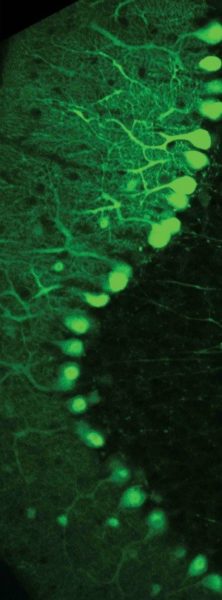University of Pennsylvania researchers have made another advance in understanding how the brain detects errors caused by unexpected sensory events. This type of error detection is what allows the brain to learn from its mistakes, which is critical for improving fine motor control.
Their previous work explained how the brain can distinguish true error signals from noise; their new findings show how it can tell the difference between errors of different magnitudes. Fine-tuning a tennis serve, for example, requires that the brain distinguish whether it needs to make a minor correction if the ball barely misses the target or a much bigger correction if it is way off.
The study was led by Javier Medina, an assistant professor in the Department of Psychology in Penn’s School of Arts & Sciences, and Farzaneh Najafi, then a graduate student in the Department of Biology. They collaborated with postdoctoral fellow Andrea Giovannucci and associate professor Samuel S. H. Wang of Princeton University.
It was published in the journal eLife.
Our movements are controlled by neurons known as Purkinje cells. Each muscle receives instructions from a dedicated set of hundreds of these brain cells. The instructions sent by each set of Purkinje cells are constantly fine tuned by climbing fibers, a specialized group of neurons that alert Purkinje cells whenever an unexpected stimulus occurs.
“An unexpected stimulus is often a sign that something has gone wrong,” Medina said, “When this happens, climbing fibers send signals to their related Purkinje cells that an error has occurred. These Purkinje cells can then make changes to avoid the error in the future.”
These error signals are mixed in with random firings of the climbing fibers, however, and researchers were long mystified about how the brain tells the difference between this noise and the useful, error-related information it needs to improve motor control.
Medina and his team showed the mechanism behind this differentiation in a study published earlier this year. By using a non-invasive microscopy technique that could monitor the Purkinje cells of awake and active mice, the researchers could measure the level of calcium within these cells when they received signals from climbing fibers.
The unexpected stimuli in this experiment were random puffs of air to the face, which caused the mice to blink. The researchers located Purkinje cells that control the mice’s eyelids and saw that calcium levels necessary for neuroplasticity, i.e., the brain’s ability to learn, were greater when the mice got an error signal triggered by a puff of air than they were after a random signal.
While being able to make such a distinction is critical to the brain’s ability to improve motor control, more information is needed to fine-tune it.
“We wanted to see if the Purkinje cells could tell the difference not just between random firings and true errors signals but between smaller and bigger errors,” Medina said.
In their new study, the researchers used the same experimental set-up, with one key difference. They used air puffs of different durations: 15 milliseconds and 30 milliseconds.
What they found was that the eyelid-associated Purkinje cells filled with different amounts of calcium depending on the length of the puff; the longer ones produced larger spikes in calcium levels.
In addition, the researchers saw that different percentages of eyelid-related Purkinje cells respond depending on the length of the puff.
“Though there is a large population of climbing fibers that can give error-related information to the relevant Purkinje cells when they encounter something unexpected, not all of them fire each time,” Medina said. “We saw that there is information coded in the number of climbing fibers that fire. The longer puffs corresponded to more climbing fibers sending signals to their Purkinje cells.”
Their study could help explain how practice makes perfect, even when errors are imperceptibly small.
“If you felt a short puff and a long puff, you might not be able to say which one was which, but Purkinje cells can tell the difference,” Medina said. “The difference between a ‘very good’ and an ‘awesome’ tennis serve rests on being able to distinguish errors even as tiny as that.”
The research was supported by the National Institutes of Health, Searle Scholars Program, New Jersey Commission on Brain Injury Research and W. M. Keck Foundation.


